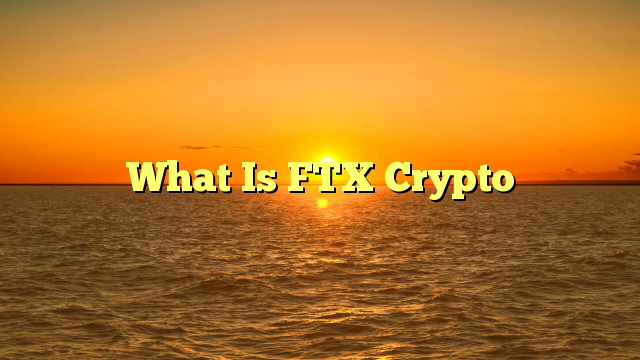What is FTX Crypto? A Primer on the Defunct Exchange and its FTT Token. FTX, formerly known as FTX Trading Ltd., was a cryptocurrency exchange that rose to prominence in the early 2020s, only to experience a spectacular downfall in November 2022. Founded by Sam Bankman-Fried (SBF) in 2019, FTX Crypto quickly gained traction for its innovative derivatives products and user-friendly interface. At its peak, FTX boasted over one million users and ranked as the third-largest crypto exchange globally by trading volume. However, a series of allegations regarding misuse of customer funds and fraudulent practices led to a liquidity crisis, ultimately forcing FTX to declare bankruptcy and its executives facing criminal charges.
This comprehensive guide explain what is FTX Crypto, dissecting its meteoric rise and its swift collapse. We’ll explore the following key areas:
Understanding Cryptocurrency Exchanges: A foundational understanding of crypto exchanges is crucial before delving into FTX. These platforms act as intermediaries, allowing users to buy, sell, and trade cryptocurrencies. They connect buyers and sellers, facilitate transactions, and ensure secure storage of digital assets.
What is FTX Crypto Offerings: Beyond facilitating spot trading for popular cryptocurrencies like Bitcoin and Ethereum, FTX distinguished itself by offering a wide range of derivatives products. These included futures contracts, options, and leveraged tokens, catering to experienced traders seeking advanced investment strategies.
The Allure of FTT Tokens: FTX issued its native token, FTT, in 2019. Owning FTT tokens entitled users to various benefits on the platform, such as reduced trading fees and participation in exclusive token offerings (IEOs). This strategy aimed to incentivize user loyalty and platform usage.
Top 10 Things to Know About FTX Crypto (Pre-Bankruptcy)
Rapid Growth Trajectory: FTX Crypto ascent in the market was remarkable. It secured significant investments from prominent venture capitalists, propelling its valuation to a staggering $32 billion in 2022.
Focus on Derivatives: FTX carved a niche by catering to sophisticated investors with its derivatives offerings. These products allowed users to speculate on the future price movements of cryptocurrencies with amplified gains (and losses).
FTT Token Utility: FTX leveraged its native token, FTT, to incentivize platform usage. Owning FTT offered benefits like fee discounts, voting rights on platform governance, and participation in exclusive token sales.
Marketing Blitz: FTX aggressively marketed itself through high-profile sponsorships, including naming rights for major sporting events and partnerships with professional athletes.
Regulatory Scrutiny: Despite its success, FTX faced increasing scrutiny from regulatory bodies worldwide due to the lack of transparency surrounding its operations and the inherent risks associated with derivative products.
The Alameda Research Connection: Concerns arose regarding FTX’s close ties with Alameda Research, a crypto hedge fund also founded by SBF. The potential for conflicts of interest and the opaqueness of their financial relationship fueled public anxieties.
Liquidity Crisis and Collapse: In November 2022, a liquidity crisis engulfed FTX after a report exposed potential financial irregularities. Users rushed to withdraw funds, leading to a domino effect and ultimately forcing FTX to file for bankruptcy.
Criminal Charges Against SBF: Following the collapse of FTX, SBF faced criminal charges from the US Securities and Exchange Commission (SEC) for allegedly defrauding investors and misappropriating customer funds.
Impact on the Crypto Market: The FTX debacle sent shockwaves through the crypto industry, eroding investor confidence and highlighting the need for stricter regulations within the decentralized finance (DeFi) space.
The Future of FTX Remains Uncertain: As of May 2024, legal proceedings against SBF are ongoing. The fate of FTX’s assets and the potential revival efforts for the exchange remain shrouded in uncertainty.
How FTX Crypto Worked: A User’s Guide (Pre-Bankruptcy)
For users interested in trading cryptocurrencies on FTX (prior to its bankruptcy), the process was relatively straightforward:
Account Creation: Signing up for an FTX account involves a standard KYC (Know Your Customer) verification process, requiring identification documents for security purposes.
Funding the Account: Users could deposit funds to their FTX accounts through various methods, including bank transfers, credit/debit cards, and cryptocurrency deposits from external wallets.
Trading Interface: FTX offers a user-friendly trading interface with options for spot trading, derivatives contracts, and margin trading (borrowing funds to amplify returns).
FTT Token Integration: Holding FTT tokens unlocked benefits like fee discounts, participation in governance votes to influence platform decisions, and the ability to participate in exclusive token offerings (IEOs) – a highly sought-after privilege for those seeking early exposure to promising new crypto projects.
Recent News and Developments Surrounding FTX Crypto (as of May 7, 2024)
The FTX Crypto saga continues to unfold, with several key developments emerging in recent months:
SBF’s Trial: Sam Bankman-Fried’s criminal trial on charges of fraud and market manipulation is ongoing. The outcome of this trial will have significant implications for the future of cryptocurrency regulation and could set a precedent for similar cases.
Recovery Efforts: Lawyers and bankruptcy professionals are currently working to recover assets from FTX for potential distribution to creditors. The estimated value of recoverable assets remains unclear, and the process is likely to be lengthy and complex.
Regulatory Scrutiny Intensifies: The FTX debacle has intensified regulatory scrutiny of the crypto industry globally. Regulators are pushing for stricter KYC/AML (Anti-Money Laundering) compliance, increased transparency from exchanges, and tighter controls on derivatives products.
FTX’s Legacy: Despite its downfall, FTX’s influence on the crypto landscape remains undeniable. Its innovative derivatives products continue to be offered by other exchanges, and its emphasis on user experience has arguably set a benchmark for the industry.
The Rise of Decentralized Alternatives: The FTX collapse has fueled interest in decentralized exchanges (DEXs) as a potential alternative. DEXs operate on blockchain technology, eliminating the need for a central authority and offering greater control to users over their assets.
Looking Forward: The Future of Crypto Exchanges After FTX
The FTX debacle serves as a stark reminder of the inherent risks associated with cryptocurrency investments and the importance of robust regulations within the DeFi space. Moving forward, we can expect to see the following trends:
Increased Regulatory Oversight: Regulatory bodies are likely to implement stricter licensing requirements, capital adequacy standards, and consumer protection measures for crypto exchanges.
Focus on Transparency and Security: Exchanges will need to prioritize transparency in their operations, including clear disclosures on fees, risks associated with derivative products, and the security measures employed to safeguard user assets.
Rise of Decentralized Finance (DeFi): The popularity of DEXs is likely to rise as users seek greater control and autonomy over their crypto holdings. However, DEXs also present their own set of challenges, such as potential vulnerabilities to smart contract exploits.
Innovation in the Crypto Space: Despite the FTX fallout, the underlying technology of blockchain holds immense potential. We can expect continued innovation in areas like scalability, security, and interoperability between different blockchains.
Conclusion
The FTX story is a cautionary tale for the ever-evolving crypto industry. While FTX’s innovative approach initially propelled it to the forefront, its downfall highlights the critical need for responsible business practices, regulatory oversight, and transparency within the DeFi ecosystem. As the future of crypto unfolds, a focus on user protection, security, and responsible innovation will be paramount in building a sustainable and trustworthy digital asset landscape





